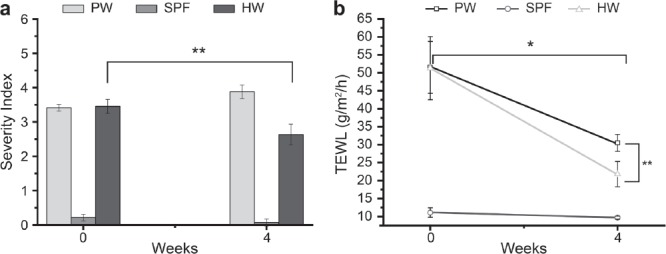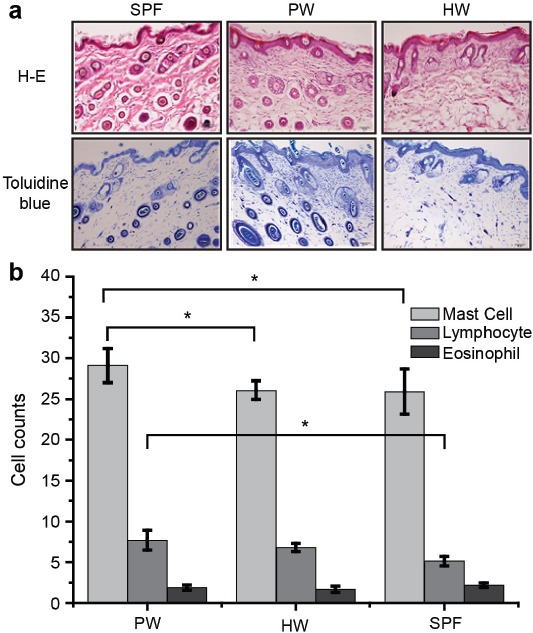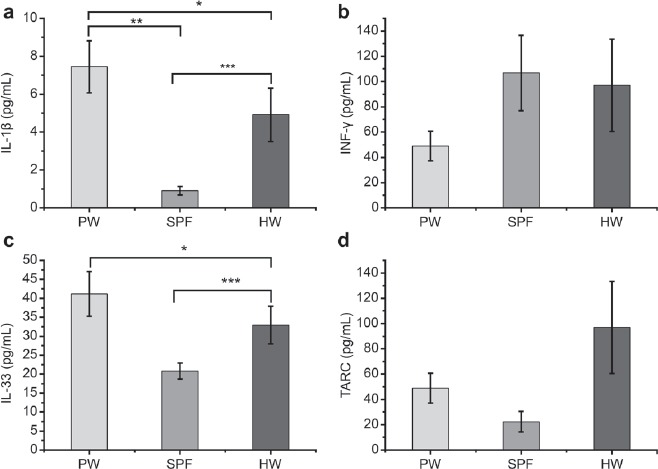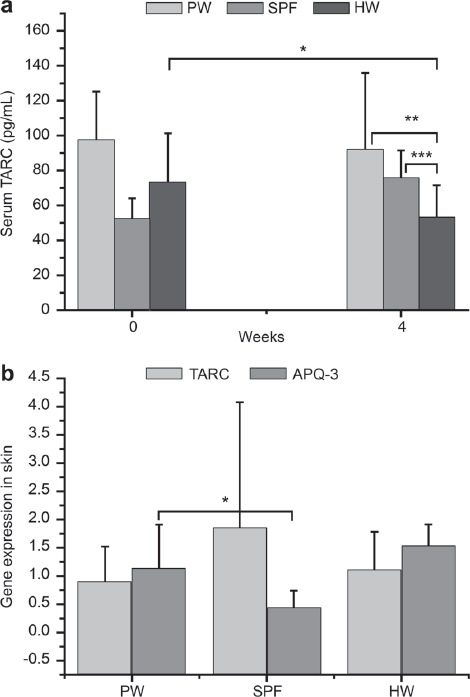Abstract
Objectives:
To examine the effect of hydrogen water (HW) on the severity of atopic dermatitis (AD) and elucidate the underlying pathophysiological mechanisms.
Methods:
For this experimental study between March 2015 and December 2015, NC/Nga mice characterized by mild AD severity were given either HW (n=11) or purified water (PW) (n=9) ad libitum; specific-pathogen-free mice (n=9) were used as AD-free control. Atopic dermatitis severity score and transepidermal water loss (TEWL) were examined at baseline (0 week), and after 4 weeks of HW/PW treatment. Levels of serum thymus and activation-regulated chemokine (TARC) and cytokines in the AD lesion were measured by ELISA; and mRNA expression of TARC and aquaporin (AQP-3) genes in the skin was examined by real-time polymerase chain reaction.
Results:
Mice treated with HW for 4 weeks demonstrated a significant decrease in the AD severity score compared with PW-treated mice (p<0.01). Hydrogen water administration also significantly reduced TEWL and serum TARC levels (p<0.01), infiltration of mast cells (p<0.05), and secretion of the proinflammatory cytokines interleukin (IL)-1β and IL-33 (p<0.05) in skin lesions compared with PW. However, no difference was observed between PW and HW groups in interferon-g secretion and expression of AQP-3 and TARC genes.
Conclusion:
Hydrogen water suppressed inflammation in AD mice, leading to amelioration of disease severity, which suggests the therapeutic potential of HW in AD treatment.
Atopic dermatitis (AD) is a chronic inflammatory disease of the skin affecting 5–20% of children worldwide. Atopic dermatitis is manifested by red, itchy, dry skin lesions of various severity, and is associated with considerable morbidity and poor quality of life.1 The diagnosis is made based on chronicity, degree of itching, relapses, and lesion morphology. Although the etiology of AD is unknown, it is thought that inflammation and oxidative stress together with genetic background and environmental factors contribute to disease pathology.2-4
Hydrogen water (HW) contains dissolved molecular hydrogen, which has high potential in alleviating oxidative stress, and it has shown therapeutic effects in several pathological conditions, including AD.5-10 Hydrogen water has been reported to enhance glutathione peroxidase activity and downregulate thymus and activation-regulated chemokine (TARC), which is implicated in the pathogenesis of AD and used as an indicator of disease severity.10 Thymus and activation-regulated chemokine binds to the chemokine receptor CCR4 and induces chemotaxis in T cells, thus acting as a proinflammatory factor in AD, and it is suggested that HW may have therapeutic potential in AD by reducing TARC. However, there is a lack of information on effects of HW in AD and the underlying physiological and molecular mechanisms.
In addition to TARC, other factors may be involved in the inflammatory mechanisms activated in AD. Among them, aquaporin-3 (AQP-3), a component of water-permeable channels expressed in epidermal keratinocytes, plays a key role in hydrating the healthy epidermis and is thought to mediate water loss in AD lesions.11 Furthermore, recent studies suggest that IL-33, a newly discovered cytokine that belongs to the IL-1 super-family and activates mast cells, affects the development of several allergic diseases, including AD.12,13 However, it is not known whether HW exerts it positive effects on AD by regulating AQP-3 and IL-33 levels in the skin.
In this study, we examined potential therapeutic activity of HW in AD using NC/Nga mice, which naturally develop a mild form of AD-like lesions. Mice were treated with HW or purified water (PW) and compared with regard to the AD severity score, transepidermal water loss, and serum TARC levels. Furthermore, we addressed the mechanism underlying the effects of HW in AD by evaluating cytokine production and infiltration of immune cells such as eosinophils, mast cells, and lymphocytes into AD skin lesions, and by measuring the mRNA expression of the AQP-3 and TARC genes.
Methods
Animals
For this experimental study between March 2015 and December 2015 male 12-week-old NC/Nga mice and specific-pathogen-free (SPF) mice were purchased from Japan SLC Inc. (Shizuoka, Japan). Mice were maintained under conditions of 24±2°C, 55±10% relative humidity, and 12 h-12 h light-dark cycle. All animal procedures were approved by the Institutional Animal Care and Use Committee (approval number: 27089).
Preparation of control and test water
Purified water was obtained from tap water by reverse osmosis (Elix Large; EMD Millipore Co. Ltd., Germany), and HW was prepared from PW by ultrafiltration and electrolysis (Gohda Water Treatment Technology Co., Inc., Japan). The oxidation reduction potential (ORP) was controlled at 500±30 mV (HM-21P; TOA Electronics Co., Japan), and the dissolved hydrogen (DH) level was controlled at 1.0±0.1 ppm (KM2100DH; Kyoei Denshi Co., Ltd., Japan). The resultant HW had pH 6.8±0.1.
Mouse groups and treatment
NC/Nga is an inbred strain of mice known to exhibit spontaneous dermatitis on the face and neck. Mice were randomly divided into HW-treated (n=11) and PW-treated (n=9) groups and provided ad libitum with HW or PW, respectively, placed in aluminum bottles to prevent the fast evaporation of H2 usually observed in regular bottles. Specific-pathogen-free mice used as an AD-free control (n=9) received PW. Hydrogen water and PW were replaced daily. Mice were analyzed at baseline (0 week) and 4 weeks after treatment.
Evaluation of AD severity
The severity of lesions on the dorsal skin was assessed based on four symptoms: erythema/hemorrhage, edema, erosion/excoriation, and dryness (0: no symptoms; 1: mild; 2: moderate; 3: severe) by two independent investigators who were blinded to the treatment protocol. Overall scores between 3 and 6 were defined as “mild”.
Transepidermal water loss (TEWL)
The hair on the dorsal skin was removed under isoflurane anesthesia using a depilatory cream (Veet; Reckitt Benckiser, France). Transepidermal water loss was measured using a mobile Tewameter (MSC100/TM300; Courage & Khazaka, Koeln, Germany) by placing the probe on the skin for 10 seconds; then, the results were recorded. Five measurements per mouse were obtained, and the data were expressed as g/m2/h.
Measurement of TARC and cytokines in dorsal skin
Mice were anesthetized as described; a punch biopsy with a diameter of approximately 8 mm was removed, homogenized in 500 µL of phosphate-buffered saline (PBS) containing 0.1% Tween 20, and centrifuged at 2,500×g for 10 minutes. Cytokine and chemokine levels were measured in the supernatants by sandwich enzyme-linked immunosorbent assay (ELISA) using Quantikine kits for mouse CCL17/TARC (catalog No. MCC170), IL-1β/IL-1F2 (catalog No. MLB00C), and IFN-g (catalog No. MIF00), and mouse/rat IL-33 (catalog No. M3300) (all from R&D Systems, Minneapolis, MN, USA) according to the manufacturer’s protocol. Raw fluorescence data were obtained in a Spectra Max plus 384 microplate reader (Molecular Devices, CA, USA) and analyzed by the four-parameter logistic method.
Thymus and activation-regulated chemokine levels in blood
Serum concentration of TARC was measured by ELISA using the CCL17/TARC Quantikine Kit and the Spectra Max plus 384 according to the manufacturer’s protocol.
Quantitative real-time polymerase chain reaction (qPCR)
The dorsal skin of each mouse was excised and snap-frozen in liquid nitrogen, and total RNA was isolated with QIAzol Lysis Reagent (QIAGEN, Hilden, Germany) and purified using the RNeasy Mini Kit (QIAGEN). cDNA was synthesized with the RivertAid First Strand cDNA Synthesis Kit (TOYOBO, Osaka, Japan) and stored at -80°C. The expression of AQP-3, TARC, and glyceraldehyde 3-phosphate dehydrogenase (GAPDH) mRNA was measured using QIAGEN RT² qPCR Primer Assays (PPM28144B-200, PPM02963B, and PPM02946E-200, respectively) in an MX3005P real-time qPCR system (Agilent Technologies, Santa Clara, CA, USA). Polymerase chain reaction primers for AQP-3 were 5¢-GTGGCATGCCTGGTGGGTTGCCATGTCTCCTTCC-3¢ (sense) and 5¢-TTGCTGCCGCGAGGCAGGCTCTGAGGAGAGTG-3¢ (antisense), and those for TARC were 5¢-CTTCTCTGCAGCACATCC-3¢ (sense) and 5¢-AAGACCTCTCAAGGCTTTG-3¢ (antisense). Relative mRNA expression was calculated by the 2ΔΔCt method14 using MX3005P software and the results were normalized to those for GAPDH mRNA used as an endogenous control.
Histopathology
The dorsal skin was excised, fixed in 4% paraformaldehyde, and embedded in paraffin; then, 2-µm-thick sections were cut, stained with hematoxylin and eosin (H&E) or toluidine blue (TB), and the number of eosinophils, lymphocytes, and mast cells were counted at 400× magnification and calculated per 0.025 mm2 of skin.
Statistical analysis
All data are presented as the mean±standard error (SE) and analyzed by t-tests using GraphPad Prism 7.03 for Windows. Two-tailed p<0.05 was considered statistically significant.
Results
Hydrogen water reduced AD scores
As shown in Figure 1a, the HW and PW groups had similar AD scores at baseline (p>0.05). However, 4 weeks after treatment, the AD score decreased significantly in the HW group compared to week 0 (from 3.4±0.2 to 2.6±0.3; p<0.05) and was significantly lower compared to that in the PW group (Table 1). Control SPF mice did not develop AD.
Figure 1.

Hydrogen water administration improves AD symptoms. a) Effects of HW treatment on AD severity. The severity of skin lesions was scored at 0 (baseline) and 4 weeks; **p<0.05. b) Effects of HW on TEWL; *p< 0.05 (HW mice, 0 versus 4 weeks) and **p<0.05 (PW versus HW at 4 weeks). All data are expressed as the mean±SEM (n=4 per group). AD - atopic dermatitis, HW - hydrogen water, SPF - specific-pathogen-free, PW - purified water, TEWL - transepidermal water loss
Table 1.
hydrogen water decreases AD scores, skin inflammation, and serum TARC levels in NC/Nga mice after 4 weeks of treatment.

Hydrogen water alleviated TEWL
After 4 weeks, TEWL was significantly decreased both in the PW and HW groups (p<0.05), whereas no changes were observed in the SPF group (Figure 1b). However, the HW group had significantly lower TEWL than the PW group (p<0.05) (Table 1).
Hydrogen water decreased infiltration of mast cells into AD skin lesions
Figure 2 shows infiltration of immune cells in the mouse skin. The number of infiltrating mast cells per 0.025 mm2 was significantly elevated in the PW group compared to the SPF group (p=0.0359); however, HW treatment caused a significant decrease in mast cell infiltration (p=0.0055) (Table 1) to the level of AD-free (SPF) mice (p=0.9488, HW versus SPF; Figure 2b). The number of lymphocytes per 0.025 mm2 was higher in the PW group than in the SPF group (p=0.4602), but there was no difference between the PW and HW groups, whereas eosinophil counts were similar in all mice (p=0.7008) (Figure 2b).
Figure 2.

Infiltration of eosinophils, mast cells, and lymphocytes in AD skin lesions. a) Representative images of skin tissue sections were examined after H&E staining (lymphocytes and eosinophils) or toluidine blue staining (mast cells). b) Immune cells were counted under a microscope and the results expressed as the mean±SEM of the number of cells per 0.025 mm2 of skin at week 4 (n=4 mice per group); *p<0.05. Red arrowheads indicate mast cells in toluidine blue staining. Blue arrowheads indicate lymphocytes. Black arrowheads indicate neutrophils. AD - atopic dermatitis, HW - hydrogen water, SPF - specific-pathogen-free, PW - purified water
Hydrogen water downregulated IL-1β and IL-33 secretion in AD skin lesions
After 4 weeks, the level of the proinflammatory cytokine IL-1β was higher in the PW group than in the SPF group (p=0.0003), but significantly lower in the HW group than in the PW group (p<0.05) (Table 1 & Figure 3a). Similarly, IL-33 levels were significantly higher in the PW group than in the HW group (p<0.05; Table 1 and Figure 3c). However, no differences were observed among the groups in skin IFN-g or TARC levels (Figure 3 b, d).
Figure 3.

Effects of HW on the expression of cytokines and TARC in AD skin lesions. The levels of (a) IL-1β, (b) INF-β, (c) IL-33, and (d) TARC were determined by ELISA 4 weeks after the start of HW treatment. The results are presented as the mean±SEM (n=4 mice per group); *p<0.05 (PW versus HW), **p<0.05 (PW versus SPF), and **p<0.05 (SPF versus HW). HW - hydrogen water, SPF - specific-pathogen-free, PW - purified water, TARC - thymus and activation-regulated chemokine, IL-1β - interleukin 1β , IL-33 - interleukin 33
Hydrogen water decreased serum TARC levels
TARC secretion was also measured in serum. Hydrogen water treatment decreased serum TARC levels from 73.3±27.9 pg/mL at baseline to 53.2±18.3 pg/mL at week 4 (p=0.0107); however, no differences were detected between baseline and 4-week levels in the PW or SPF group (p=0.7419, Figure 4a).
Figure 4.

Effects of HW on serum TARC levels and expression of TARC and AQP-3 mRNA. a) Serum concentrations of TARC were compared at 0 and 4 weeks of HW administration by ELISA. *p<0.05 (HW mice, 0 versus 4 weeks), **p<0.05 (PW versus HW at 4 weeks), ***p<0.05 (SPF versus HW at 4 weeks). b) Effects of HW on the expression of TARC and AQP-3 mRNA in AD skin lesions were analyzed by real-time qPCR after 4 weeks of HW administration. The results were normalized to GAPDH mRNA levels used as control; *p<0.05 (PW versus HW). All data are shown as the mean±SEM (n=4 mice per group). HW - hydrogen water, SPF - specific-pathogen-free, PW - purified water, TARC - thymus and activation-regulated chemokine, APQ-3 - aquaporin
mRNA expression of TARC and AQP-3 in skin lesions
Figure 4b shows that there were no significant differences in AQP-3 and TARC expression between the HW and SPF groups, or between the HW and PW groups; however, AQP-3 mRNA was significantly upregulated in PW compared to SPF mice (p=0.0125).
Discussion
In this study, we showed that HW alleviated the severity of AD in NC/Nga mice through suppression of skin inflammation, as evidenced by the reduced IL-1β and IL-33 levels and decreased infiltration of mast cells in AD skin lesions. Hydrogen water is known to attenuate several pathological conditions, including neuropathic pain, pulmonary hypertension, and neurodegeneration.5-8 However, the effects of HW in AD are controversial. A group from Korea found no or only slight effects on AD severity in NC/Nga mice treated with HW for 12 weeks, although changes in the redox balance and inflammation were detected.9,10 In contrast, we observed a significant amelioration of AD symptoms after 4 weeks of HW administration. This discrepancy may be explained by the differences in AD severity scores at baseline, as we used mice with “mild” AD (score 3–5), whereas Yoon et al10 used mice with a severity score of approximately 2.5. Therefore, our results are particularly noteworthy as they are the first to demonstrate the therapeutic efficacy of HW in terms of reduced severity score in mild AD lesions.
We found that in AD skin lesions, the IL-1β level was significantly decreased and infiltration of mast cells was reduced after 4 weeks of HW administration, indicating amelioration of the proinflammatory environment. Consistent with our results, previous studies showed that some natural extracts mitigated AD by reducing IL-1β expression and infiltration of mast cells into the dermal and subcutaneous layers of AD mice,15,16 confirming that IL-1β and mast cells are associated with AD severity. We also found that the level of IL-33, which is known to be expressed by activated mast cells13 was lower in the HW group. As IL-33 has an autocrine function promoting activation of mast cells, the efficacy of HW in ameliorating AD symptoms can be attributed to the downregulation of IL-33 secretion and suppression of mast cell activation in AD skin lesions.12 In addition, the IL-33 receptor is also expressed on Th2 cells and group 2 innate lymphocytes, suggesting that IL-33 downregulation in AD skin may improve inflammation through multiple mechanisms.17
We also observed that HW treatment significantly decreased serum TARC levels, although the expression of the TARC gene was not affected. Serum TARC concentration is used as a marker of AD;18-22 therefore, the reduction of TARC release into blood after HW administration supports the notion that HW attenuates AD severity. Furthermore, our results revealed significant reduction in TEWL by HW, indicating improvement in skin barrier function. However, the expression of AQP-3, which transports water and small solutes across the plasma membrane,23 was not changed by HW; therefore, further research is required to fully understand the role of AQP-3 in regulating water balance in AD skin.
Study limitations
The observation period was rather short (4 weeks) and there were only two test points, which could not fully reveal the dynamics of HW therapeutic activity in AD; in addition, cytokine expression in the AD skin was not confirmed by qPCR. Future long-term studies including in-depth profiling of proinflammatory mediators are required to comprehensively evaluate the potential of HW in AD.
In conclusion, HW treatment reduced the AD severity score and TEWL by improving the immune environment in the AD skin through downregulation of IL-1β and IL-33 and prevention of mast cell infiltration at the lesion site. Taken together, our results strongly suggest that HW treatment has therapeutic benefits in AD. Future studies should focus on investigating the effects of long-term HW administration as a potential therapeutic modality for AD.
Acknowledgment
We would like to express our gratitude to Editage (www.editage.com) for medical writing, copyediting, fact checking, and referencing. We would also thank Gohda Water Treatment Technology Co., Inc., Japan for the provision of the HW generator.
Footnotes
References
- 1.Lifschitz C. The impact of atopic dermatitis on quality of life. Ann Nutr Metab. 2015;66:34–40. doi: 10.1159/000370226. [DOI] [PubMed] [Google Scholar]
- 2.Barton M, Sidbury R. Advances in understanding and managing atopic dermatitis. F1000Res. 2015;4:F1000. doi: 10.12688/f1000research.6972.1. Faculty Rev-1296. [DOI] [PMC free article] [PubMed] [Google Scholar]
- 3.Dembic Z, editor. The role and regulation of the immune responses. The Cytokines of the Immune System. Cambridge (Massachusetts): Academic Press; 2015. pp. 99–122. [Google Scholar]
- 4.Hengge UR, Ruzicka T, Schwartz RA, Cork MJ. Adverse effects of topical glucocorticosteroids. J Am Acad Dermatol. 2006;54:1–15. doi: 10.1016/j.jaad.2005.01.010. [DOI] [PubMed] [Google Scholar]
- 5.McCarty MF. Potential ghrelin-mediated benefits and risks of hydrogen water. Med Hypotheses. 2015;84:350–355. doi: 10.1016/j.mehy.2015.01.018. [DOI] [PubMed] [Google Scholar]
- 6.Kawaguchi M, Satoh Y, Otsubo Y, Kazama T. Molecular hydrogen attenuates neuropathic pain in mice. PLoS One. 2014;9:e100352. doi: 10.1371/journal.pone.0100352. [DOI] [PMC free article] [PubMed] [Google Scholar]
- 7.He B, Zhang Y, Kang B, Xiao J, Xie B, Wang Z. Protection of oral hydrogen water as an antioxidant on pulmonary hypertension. Mol Biol Rep. 2013;40:5513–5521. doi: 10.1007/s11033-013-2653-9. [DOI] [PMC free article] [PubMed] [Google Scholar]
- 8.Dohi K, Kraemer BC, Erickson MA, McMillan PJ, Kovac A, Flachbartova Z, et al. Molecular hydrogen in drinking water protects against neurodegenerative changes induced by traumatic brain injury. PLoS One. 2014;9:e108034. doi: 10.1371/journal.pone.0108034. [DOI] [PMC free article] [PubMed] [Google Scholar]
- 9.Ignacio RMC, Kwak HS, Yun YU, Sajo ME, Yoon YS, Kim CS, et al. The drinking effect of hydrogen water on atopic dermatitis induced by Dermatophagoides farinae allergen in NC/Nga mice. Evid Based Complement Alternat Med. 2013;2013:5. doi: 10.1155/2013/538673. [DOI] [PMC free article] [PubMed] [Google Scholar]
- 10.Yoon YS, Sajo ME, Ignacio RM, Kim SK, Kim CS, Lee KJ. Positive effects of hydrogen water on 2,4-dinitrochlorobenzene-induced atopic dermatitis in NC/Nga mice. Biol Pharm Bull. 2014;37:1480–1485. doi: 10.1248/bpb.b14-00220. [DOI] [PubMed] [Google Scholar]
- 11.Olsson M, Broberg A, Jernås M, Carlsson L, Rudemo M, Suurküla M, et al. Increased expression of aquaporin 3 in atopic eczema. Allergy. 2006;61:1132–1137. doi: 10.1111/j.1398-9995.2006.01151.x. [DOI] [PubMed] [Google Scholar]
- 12.Saluja R, Khan M, Church MK, Maurer M. The role of IL-33 and mast cells in allergy and inflammation. Clin Transl Allergy. 2015;5:1–8. doi: 10.1186/s13601-015-0076-5. [DOI] [PMC free article] [PubMed] [Google Scholar]
- 13.Theoharides TC, Petra AI, Taracanova A, Panagiotidou S, Conti P. Targeting IL-33 in autoimmunity and inflammation. J Pharmacol Exp Ther. 2015;354:24–31. doi: 10.1124/jpet.114.222505. [DOI] [PubMed] [Google Scholar]
- 14.Schmittgen TD, Livak KJ. Analyzing real-time PCR data by the comparative CT method. Nat Protoc. 2008;3:1101–1108. doi: 10.1038/nprot.2008.73. [DOI] [PubMed] [Google Scholar]
- 15.Yang H, Ahn C, Choi IG, Choi WS, Park MJ, Lee SS, et al. Estimation of the environmental effect of natural volatile organic compounds from Chamaecyparis obtusa and their effect on atopic dermatitis-like skin lesions in mice. Mol Med Rep. 2015;12:345–350. doi: 10.3892/mmr.2015.3431. [DOI] [PubMed] [Google Scholar]
- 16.Kim T, Park K, Jung HS, Kong WS, Jeon D, Lee SH. Evaluation of anti-atopic dermatitis activity of Hypsizigus marmoreus extract. Phytother Res. 2014;28:1539–1546. doi: 10.1002/ptr.5164. [DOI] [PubMed] [Google Scholar]
- 17.Murakami-Satsutani N, Ito T, Nakanishi T, Inagaki N, Tanaka A, Vien PT, et al. IL-33 promotes the induction and maintenance of Th2 immune responses by enhancing the function of OX40 ligand. Allergol Int. 2014;63:443–455. doi: 10.2332/allergolint.13-OA-0672. [DOI] [PubMed] [Google Scholar]
- 18.Bogaczewicz J, Malinowska K, Sysa-Jedrzejowska A, Wozniacka A. Medium-dose ultraviolet A1 phototherapy and mRNA expression of TSLP, TARC, IL-5, and IL-13 in acute skin lesions in atopic dermatitis. Int J Dermatol. 2016;55:856–863. doi: 10.1111/ijd.12992. [DOI] [PubMed] [Google Scholar]
- 19.Ahrens B, Schulz G, Bellach J, Niggemann B, Beyer K. Chemokine levels in serum of children with atopic dermatitis with regard to severity and sensitization status. Pediatr Allergy Immunol. 2015;26:634–640. doi: 10.1111/pai.12431. [DOI] [PubMed] [Google Scholar]
- 20.Saeki H, Tamaki K. Thymus and activation regulated chemokine (TARC)/CCL17 and skin diseases. J Dermatol Sci. 2006;43:75–84. doi: 10.1016/j.jdermsci.2006.06.002. [DOI] [PubMed] [Google Scholar]
- 21.Thijs J, Krastev T, Weidinger S, Buckens CF, de Bruin-Weller M, Bruijnzeel-Koomen C, et al. Biomarkers for atopic dermatitis: a systematic review and meta-analysis. Curr Opin Allergy Clin Immunol. 2015;15:453–460. doi: 10.1097/ACI.0000000000000198. [DOI] [PubMed] [Google Scholar]
- 22.Gu CY, Gu L, Dou X. Serum levels of thymus and activation-regulated chemokine can be used in the clinical evaluation of atopic dermatitis. Int J Dermatol. 2015;54:e261–e265. doi: 10.1111/ijd.12830. [DOI] [PubMed] [Google Scholar]
- 23.Guo L, Chen H, Li Y, Zhou Q, Sui Y. An Aquaporin 3-Notch1 Axis in keratinocyte differentiation and inflammation. PLoS One. 2013;8:e80179. doi: 10.1371/journal.pone.0080179. [DOI] [PMC free article] [PubMed] [Google Scholar]


